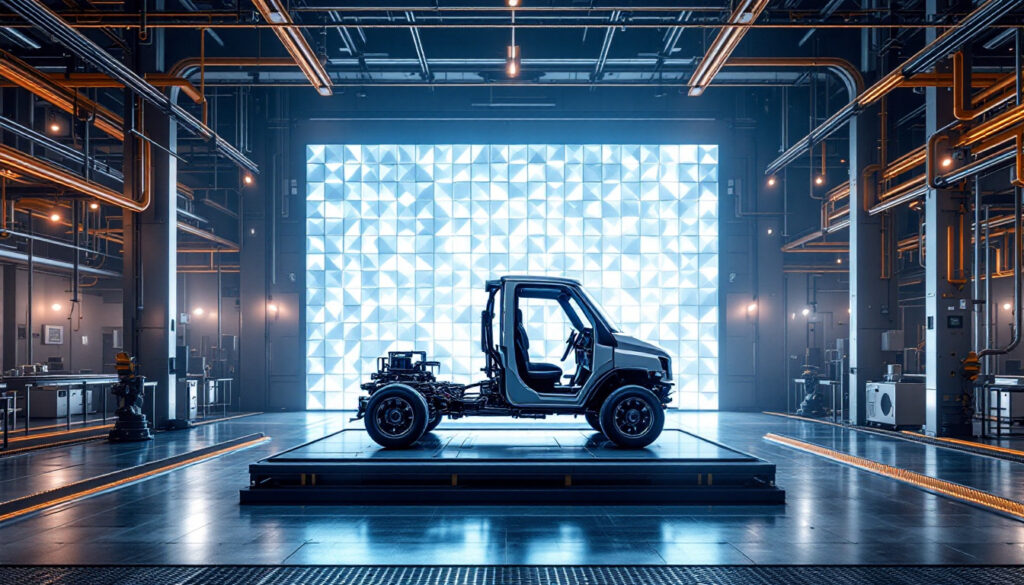The Strategic Partnership Between GM and LG Energy Solution
General Motors and LG Energy Solution have forged a groundbreaking partnership that promises to reshape the electric vehicle landscape through innovative battery technology. This collaboration marks a significant step forward in addressing one of the primary barriers to widespread EV adoption: battery cost.
Timeline and Production Goals
GM and LG Energy Solution have announced plans to begin commercial production of new lower-cost battery cells by 2028. These advanced cells will be manufactured at one of their joint-venture Ultium Cells plants, located in either Ohio or Tennessee, leveraging existing infrastructure to streamline implementation.
The partnership aims to support GM's rapidly expanding electric vehicle lineup, which currently features 12 models across various segments. This strategic collaboration represents a long-term commitment to scaling domestic battery production and establishing a sustainable supply chain.
"Our timeline reflects the thorough development and testing needed to ensure these cells meet our rigorous performance and safety standards," explained Kurt Kelty, GM's Vice President of Battery, Propulsion and Sustainability. "We're building toward a future where EVs transforming transport aren't just competitive but compelling."
The Ultium Cells Joint Venture
Ultium Cells represents the formalized battery manufacturing collaboration between GM and LG Energy Solution, established in 2019 with an initial investment of $2.3 billion. The joint venture currently operates two battery manufacturing facilities in the United States, with operations having commenced in 2022.
This strategic partnership allows GM to secure domestic battery production capacity while leveraging LG's extensive expertise in battery technology development. By combining GM's automotive engineering excellence with LG's battery innovation capabilities, Ultium Cells is positioned to accelerate the transition to electric mobility.
The joint venture's manufacturing facilities incorporate advanced automation and quality control systems, ensuring consistent production of high-performance battery cells while creating thousands of skilled manufacturing jobs across the American heartland.
How Will LMR Battery Technology Transform EV Economics?
The introduction of Lithium Manganese-Rich (LMR) battery technology represents a paradigm shift in electric vehicle economics, potentially unlocking new levels of affordability while maintaining performance standards.
The Science Behind Lithium Manganese-Rich (LMR) Cells
LMR cells utilize an innovative chemistry that significantly reduces dependency on expensive nickel components. Unlike conventional nickel-manganese-cobalt (NMC) batteries that dominate today's market, LMR cells incorporate a higher proportion of manganese—an abundant and relatively inexpensive element.
The technology maintains high energy density while using more accessible and affordable materials, addressing both cost and supply chain vulnerabilities. Current industry estimates suggest that approximately 70% of NMC cathodes rely heavily on nickel, making GM's strategic pivot toward manganese particularly significant.
Perhaps most notably, these cells will feature a prismatic structure rather than the pouch design currently used in GM's EVs. This architectural shift reduces battery pack component count by over 50%, dramatically streamlining manufacturing processes and reducing complexity.
Performance Expectations
Despite the cost-oriented design, GM projects these cells will enable over 400 miles of range on a single charge for electric trucks—a critical benchmark for consumer acceptance in this vehicle segment. This performance target addresses one of the most significant barriers to EV adoption for truck and SUV buyers: range anxiety.
"Consumers want range without premium pricing," Kelty noted. "These LMR cells deliver both, making electric trucks and SUVs more accessible to mainstream buyers."
The technology maintains performance standards comparable to nickel-rich cells while significantly reducing battery costs. Enhanced thermal management capabilities inherent to the prismatic design also contribute to improved charging performance and battery longevity—critical factors for commercial success in the truck and SUV segments.
These cells are specifically engineered to power future electric trucks and full-size SUVs, addressing range concerns in larger vehicles that have traditionally been challenging to electrify cost-effectively.
What Cost Benefits Will the New Battery Technology Deliver?
The economic advantages of LMR technology extend beyond manufacturing simplification, potentially reshaping the EV cost equation in fundamental ways.
Projected Cost Reductions
GM expects to reduce battery pack costs by $30 per kilowatt-hour by 2025 through the implementation of LMR technology and associated manufacturing improvements. This substantial cost reduction puts the company on track to achieve the industry's holy grail: cost parity between EVs and internal combustion engine vehicles.
"My mission here is to get as many EVs on the road as possible," explains Kurt Kelty. "We need to get price parity with [gas-powered vehicles]. Cost parity is the linchpin for mass adoption."
Industry analysts estimate current battery pack costs hover around $110/kWh, making the projected $30/kWh reduction a game-changing 27% improvement. This cost trajectory aligns with BloombergNEF projections that suggest $100/kWh represents the threshold at which EVs become cost-competitive with traditional vehicles without subsidies.
Manufacturing Efficiencies
The prismatic cell design introduces substantial manufacturing efficiencies that contribute significantly to cost reduction:
- Simplified Assembly: Prismatic cells eliminate more than 50% of battery pack components compared to pouch cells
- Improved Yields: Reduced complexity translates to lower defect rates and higher production yields
- Streamlined Integration: Rectangular form factor enables more efficient pack designs and thermal management
- Automated Production: Prismatic cells are better suited to highly automated manufacturing processes
These manufacturing advantages compound over time, particularly as production scales. The simplified design also improves quality control metrics and reduces the likelihood of manufacturing defects, further enhancing both cost efficiency and consumer confidence.
Disclaimer: Cost reduction projections are based on current material prices and technology development trajectories. Actual savings may vary depending on market conditions and technological breakthroughs.
How Does This Fit Into GM's Broader EV Strategy?
GM's LMR battery initiative represents one component of a comprehensive and multi-faceted approach to electrification, designed to address diverse market segments and consumer needs.
Diversified Battery Chemistry Approach
GM is implementing a sophisticated, flexible chemistry strategy to optimize range, performance, and affordability across its vehicle lineup. This approach includes:
- LMR Cells: Targeted at trucks and full-size SUVs, balancing range and cost
- LFP (Lithium Iron Phosphate): Planned for more affordable compact and mid-size models
- Solid-State Technology: Long-term research investment through SolidEnergy Systems partnership for post-2030 deployment
This multi-chemistry approach allows GM to tailor battery solutions to different vehicle segments and price points, rather than forcing a one-size-fits-all solution. For instance, the company's compact EVs will likely leverage LFP technology, which offers lower energy density but even greater cost advantages for urban-focused vehicles with modest range requirements.
"Flexible chemistry lets us optimize for segment needs," according to GM's press materials. "Different customers have different priorities, and our battery strategy reflects that reality."
Competitive Positioning
GM aims to be the first automaker to commercially deploy LMR batteries in electric vehicles, with its 2028 target putting it approximately two years ahead of Ford Motor Company's similar LMR development timeline.
This race to implement lower-cost battery technologies reflects the intensely competitive landscape in EV manufacturing, particularly in the high-margin truck and SUV segments that represent approximately 60% of GM's U.S. profits.
The company's battery recycling breakthrough also positions it to compete effectively with Tesla's dual approach of 4680 cylindrical cells for premium vehicles and LFP cells for entry-level models. By developing proprietary battery solutions through the Ultium platform, GM maintains greater control over its supply chain while differentiating its product offerings.
What Impact Will This Have on GM's Electric Vehicle Lineup?
The introduction of LMR technology is poised to transform GM's electric vehicle portfolio, particularly in its most profitable and strategically important segments.
Target Vehicle Segments
The new cells are specifically designed for electric trucks and full-size SUVs—vehicle categories that represent high-margin segments critical to North American automakers. Models likely to benefit include:
- Chevrolet Silverado EV
- GMC Hummer EV
- GMC Sierra EV
- Chevrolet Blazer EV
- Future Cadillac electric SUVs
These vehicle categories have historically been challenging to electrify cost-effectively due to their size, weight, and range requirements. LMR technology specifically addresses these challenges by enabling 400+ mile range targets at reduced cost.
The focus on trucks and SUVs also aligns with broader market trends, as these segments continue to dominate U.S. vehicle sales. By targeting its most profitable vehicle categories with advanced battery technology, GM can potentially accelerate its transition to an electric future without sacrificing margins.
Anticipated Consumer Benefits
The implementation of LMR technology promises several tangible benefits for consumers:
- More Affordable Options: Potential price reductions of $15,000-$20,000 compared to current electric trucks
- Extended Range: 400+ mile capability eliminates range anxiety for most use cases
- Reduced Total Cost of Ownership: Lower initial purchase price combined with EV operating cost advantages
- Improved Charging Experience: Prismatic cells can potentially support faster charging rates
- Simplified Service Requirements: Fewer components translate to reduced maintenance complexity
For context, the current GMC Hummer EV offers 350+ miles of range with pricing starting around $110,000. LMR technology could potentially enable future iterations priced closer to $80,000-$90,000, bringing electric trucks within reach of a much broader consumer base.
Note: Vehicle pricing projections are estimates based on anticipated cost reductions. Actual pricing will depend on multiple factors including material costs, production efficiency, and competitive dynamics.
How Does This Development Compare to Industry Trends?
GM's LMR initiative reflects broader industry shifts as automakers worldwide recalibrate their battery strategies to address cost, sustainability, and supply chain concerns.
The Shift Away from Nickel-Rich Chemistries
Many automakers are reducing dependence on nickel due to cost volatility and supply chain vulnerabilities. This trend is driven by several factors:
- Price Volatility: Nickel prices have experienced significant fluctuations in recent years
- Geopolitical Concerns: Concentrated production in politically sensitive regions
- Environmental Impact: Nickel mining has substantial environmental footprints
- Competition From Other Industries: Nickel demand from stainless steel and other sectors
LMR technology represents one approach to achieving reduced nickel dependency while maintaining performance. This parallels similar efforts by Chinese manufacturers like CATL, whose M3P cells likewise aim to reduce reliance on costly materials.
The transition to manganese-rich chemistries is expected to drive a 20% annual increase in battery-grade manganese demand through 2030, potentially creating new mining opportunities in regions with manganese deposits, including parts of North America.
Global Battery Manufacturing Competition
The GM-LG partnership strengthens domestic battery production capabilities at a time when regional battery supply chains are becoming increasingly important. Key competitive factors include:
- Inflation Reduction Act Incentives: U.S. manufacturing qualifies vehicles for consumer tax credits
- Supply Chain Resilience: Reduced exposure to international shipping disruptions
- Technological Independence: Development of proprietary battery solutions
- Job Creation: Establishment of skilled manufacturing positions in the U.S.
The 2028 timeline for LMR deployment suggests a long-term strategic approach to battery technology development, balancing the need for thorough validation against competitive pressures to reach market quickly.
As Reuters has noted, "Automakers are hedging against nickel's geopolitical risks" through diversified chemistry approaches. GM's multi-faceted strategy aligns with this broader industry recognition of the need for more sustainable, secure battery supply chains.
FAQ: GM and LG's New Battery Technology
What is the main advantage of lithium manganese-rich (LMR) cells?
LMR cells offer significantly lower costs compared to nickel-rich batteries while maintaining the range performance consumers expect, particularly for larger vehicles like trucks and SUVs. By reducing dependence on expensive nickel components and utilizing more abundant manganese, these cells address both cost and supply chain vulnerabilities that have challenged EV affordability.
When will these new battery cells enter production?
Commercial production is scheduled to begin in 2028 at one of GM and LG Energy Solution's joint-venture Ultium Cells plants in the United States. This timeline reflects the extensive development, testing, and validation process required to ensure the cells meet GM's performance and safety standards while allowing for manufacturing scale-up.
How will these cells improve electric vehicles?
The cells will enable over 400 miles of range for electric trucks while reducing battery costs substantially. The prismatic design also simplifies manufacturing by reducing battery pack component count by more than 50%, streamlining assembly processes and potentially improving reliability. For consumers, these improvements translate to more affordable electric trucks and SUVs with sufficient range to eliminate range anxiety.
Is GM the only company developing this technology?
No, Ford Motor Company is also working on LMR battery technology, though GM aims to be the first to commercially deploy these batteries in production vehicles by approximately two years. Chinese manufacturers like CATL are developing similar manganese-enhanced chemistries (M3P), indicating a broader industry recognition of manganese's potential in next-generation batteries.
How does this technology fit with GM's other battery initiatives?
This is part of GM's flexible chemistry strategy, which also includes plans for lithium-iron phosphate (LFP) cells for more affordable compact and mid-size vehicles. This multi-chemistry approach allows GM to optimize battery solutions for different vehicle types and price points rather than applying a single solution across all models. The company also maintains long-term research into solid-state batteries for potential deployment beyond 2030.
Future Outlook for EV Battery Technology
Beyond LMR: Next-Generation Battery Development
While LMR technology represents a significant advancement, the industry continues to pursue even more ambitious battery innovations:
- Solid-State Batteries: Offering potential for greater energy density and safety
- Silicon-Anode Technology: Increasing capacity without proportional weight increases
- Sodium-Ion Alternatives: Eliminating lithium dependency entirely
- Structural Battery Integration: Embedding batteries into vehicle architecture
LMR cells represent an intermediate step toward more affordable and sustainable battery solutions, bridging the gap between current lithium-ion technologies and potential breakthrough chemistries still in development.
GM's strategic investments in companies like SolidEnergy Systems reflect this long-term vision, positioning the company to capitalize on future battery breakthroughs while implementing near-term solutions like LMR technology.
Supply Chain Implications
The shift toward LMR technology carries significant supply chain implications:
- Reduced Nickel Dependency: Mitigates exposure to nickel price volatility and supply constraints
- Manganese Mining Opportunities: Potential development of North American manganese resources
- Domestic Manufacturing: Strengthens regional battery production capabilities
- Recycling Potential: LMR cells may offer recycling advantages compared to current chemistries
These supply chain shifts align with broader industry efforts to establish more sustainable and resilient battery production ecosystems. As manganese demand grows, new mining and refining capacity will likely emerge, potentially creating economic opportunities in regions with manganese deposits.
The development of this technology also highlights the importance of battery metals investment as companies race to secure resources for next-generation batteries. Additionally, innovations in direct lithium extraction and the establishment of the first battery-grade lithium refinery in India demonstrate how the entire battery supply chain is evolving to support future EV growth.
Looking Forward: The battery technology landscape continues to evolve rapidly. While LMR cells represent a promising advancement, ongoing research may yield additional breakthroughs that further transform EV economics. Consumers and investors should monitor developments in this space as they may significantly impact vehicle performance, pricing, and manufacturer competitiveness in the coming decade.
Want to Profit from the Next Major Mineral Discovery?
Discovery Alert's proprietary Discovery IQ model delivers real-time notifications when significant discoveries are announced on the ASX, turning complex mineral data into actionable insights for investors. Explore how historic discoveries have generated substantial returns by visiting the Discovery Alert discoveries page and begin your 30-day free trial today to position yourself ahead of the market.




